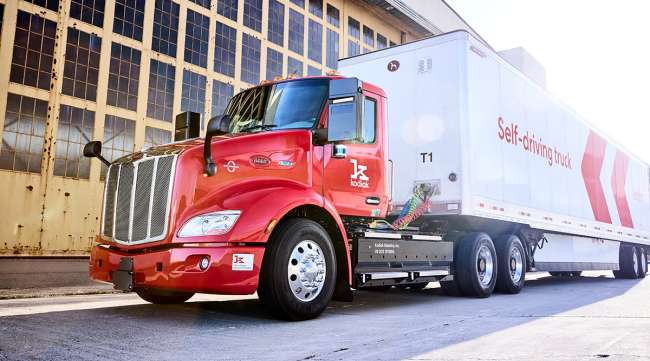Managing Editor, Features and Multimedia
Kodiak Installs Autonomous Driving System on Electric Truck

[Stay on top of transportation news: Get TTNews in your inbox.]
ANAHEIM, Calif. — Autonomous truck developer Kodiak Robotics unveiled a battery-electric Class 8 truck equipped with its self-driving technology at the 2023 Advanced Clean Transportation Expo.
The truck, a Peterbilt Model 579EV upfitted with the company’s Kodiak Driver system, brings together the development of zero-emission and autonomous trucks, technology trends that to date have largely remained separate.
“We believe that the future of trucking is the combination of electric and autonomous vehicles,” Kodiak founder and CEO Don Burnette said. “Given advancements in battery and fuel cell technologies, achieving zero-emissions trucking will soon be within reach.”
Kodiak said it plans to incorporate the zero-emission truck into its test fleet next year, joining the automated diesel-powered trucks the company already is operating on U.S. highways.
The Peterbilt Model 579EV, designed for shorthaul and drayage applications, has a range of up to 150 miles. The vehicle’s batteries can be recharged in as little as three hours.
Big news. We're introducing the first AV/EV class 8 truck equipped with the Kodiak Driver, our self-driving technology. With zero-emissions autonomous vehicles, we’re one step closer to the future of sustainable trucking.#AutonomousTrucks #ElectricVehicles pic.twitter.com/yiHGRzFA5j — Kodiak Robotics (@KodiakRobotics) May 2, 2023
Kodiak and several other autonomous truck developers have been testing their self-driving trucks predominantly in hub-to-hub operations on longhaul routes along major interstate highways. Battery-electric trucks, in contrast, are generally best suited to shorthaul routes that are a better fit for the vehicles’ range limitations and charging requirements.
But Kodiak sees opportunities for electrification and autonomy to converge.
“I think they will move further and further together and there will be quite some overlap in the future,” said Andreas Wendel, chief technology officer at Kodiak Robotics.
In the future, this combination of electrification and autonomy could expand from battery-electric trucks to hydrogen fuel cell trucks as well. “I think fuel cells are very well-positioned for the longer routes, but also batteries are improving quite a bit all the time,” Wendel said.

Wendel
Kodiak has designed its autonomous driving system to be “vehicle agnostic and powertrain agnostic,” Wendel said, meaning the company’s self-driving technology will be compatible with trucks powered by a variety of propulsion systems. Some secondary benefits of autonomous driving could also carry over from diesel to electric trucks. An autonomous driving system that helps reduce fuel consumption for diesel trucks could also help extend the range of electric vehicles by conserving power. The system also could be adapted to use the vehicle’s regenerative braking in a way that recaptures energy and further extends its range, Wendel said.
He also noted that EV charging and hydrogen fueling locations likely will emerge along some of the same major highway routes where autonomous trucks currently are being tested.
“So really, autonomy and zero-emission technology fit together well on these routes,” Wendel said.
Some other self-driving truck developers also are combining autonomous driving and electrification in various ways.
Einride is introducing electric and autonomous vehicles for the freight transportation industry, including its fully autonomous electric Pod cargo vehicle with no cab or steering wheel.
Outrider, meanwhile, is developing autonomous, electric-powered yard tractors.
Zero-emission truck manufacturer Nikola Corp. plans to offer the PlusDrive highly automated driver-assist system in its Class 8 electric trucks.
Want more news? Listen to today's daily briefing below or go here for more info:




